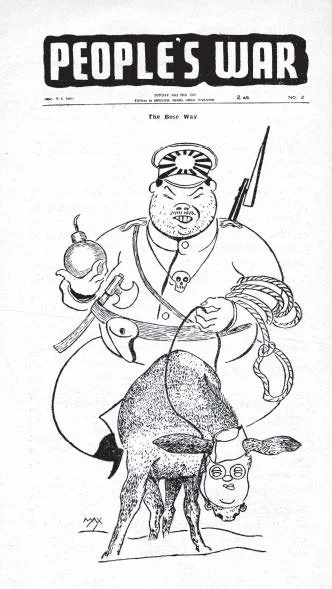Communist Party of India: Betrayal, Bose, and the Quit India Movement
Netaji Subhash Chandra Bose as a Donkey Carrying Japanese Prime Minister ToJO
Look at this cartoon. This is how the Communist Party of India (CPI) saw Subhas Chandra Bose—drawn as a donkey carrying Japan’s Prime Minister Hideki Tojo
In another sketch, the CPI warned that Bose was just a mask for Japanese imperialism.
These weren’t harmless sketches. They were propaganda weapons, printed in the CPI’s official paper, People’s War, attacking the very person raising a liberation army during India’s greatest crisis. This is the article is the story of how the Communist Party of India and the British imperial regime collaborated to crush the Quit India Movement.
People’s War: CPI’s war time propaganda publication.
Netaji Subhas Chandra Bose depicted as Mask Behind Japanese Imperialism
The Genesis: From Scattered Cells to Moscow’s Instrument
The Communist Party of India didn't start as a mass movement. It was born in Tashkent, Soviet Union, in 1920, established by M.N. Roy, who was mentored and funded by Moscow.
The party’s policies weren't decided in Bombay or Calcutta, but were dictated by the Comintern, the command center of world communism. This loyalty meant the CPI's strategy was dictated entirely by Soviet foreign policy interests:
When Moscow said “Class Against Class,” Indian communists branded Gandhi and Congress as “class enemies” When Moscow shifted to the “Popular Front” they suddenly put on khadi Gandhi caps and joined Congress rallies. Every twist, every turn followed the Soviet line. This foreign-dictated strategy meant the CPI lacked true roots and independence, a flaw that would become fatal during World War II.
The Pivot: The 'Imperialist War' Becomes the 'People's War'
When World War II began, Viceroy Linlithgow unilaterally declared India a belligerent. The Congress, led by Gandhi and Nehru, resolved to fight fascism only as a free nation.
The Communist Party of India initially mocked the nationalist movement. They branded the war an "imperialist war" (one empire vs. another) and organized factory strikes and sabotage efforts.
Then, in December 1941, the policy flipped overnight. When Hitler invaded the Soviet Union, Moscow sent instructions—relayed through the British Communist Party—ordering the CPI to support Britain.
The "imperialist war" instantly became the "people’s war." The CPI pledged unconditional support to Britain's war effort, just as Indian nationalists were preparing for their decisive movement.
A Times of India article dated July 23, 1942, mentions the lifting of the ban on the Communist Party of India and their agreement to support the British war effort
Collaboration: The CPI’s Role in Crushing Quit India 1942
The British responded to the rising nationalist fervor by arresting nearly every major Congress leader before dawn on August 9, 1942. With the Quit India Movement underway, the Communist Party of India cemented its collaboration with the colonial government.
Propaganda Against Patriots: The CPI's paper, People’s War, relentlessly attacked the nationalist movement. Subhas Bose, who had escaped house arrest to raise a liberation army, was viciously branded a "henchman of fascism" and "the paid agent of the enemy."
Espionage and Disruption: CPI members who had infiltrated Congress actively spied on the nationalist movement, reporting their activities directly to British intelligence.
Boasting to the Empire: In 1943, CPI General Secretary P.C. Joshi sent a document to the British government boasting of the party’s “splendid work” in breaking strikes and disrupting Quit India protests across the country.
While nationalist blood flowed in the streets under British repression, the communists were rewarded with state protection, access to funds, and freedom to publish. The party that claimed to fight for India’s workers was now actively fighting against India’s freedom in exchange for imperial patronage.
Newyork Times article on brutal suppression of Quit India Movement by British Imperial Government
Legacy: The Price of Disloyalty
The CPI's collaboration earned them deep unpopularity among ordinary Indians, who viewed them as traitors and collaborators.
To survive politically, the Communist Party of India sought new alliances, famously giving intellectual cover and support to the Muslim League's demand for Pakistan. The League, once denounced as "feudal," was suddenly praised as "secular"—another policy flip rooted in political expediency, not principle.
The ultimate cost of the CPI's strategy was its loyalty: it fought for Soviet foreign policy, even if that meant betraying the Quit India Movement and the cause of India's independence in 1942. The British found the perfect antidote for nationalism — communism
Sometimes, the most dangerous enemies aren’t the ones who oppose you openly…
They’re the ones inside your camp, holding your flag.
Sources:
Netaji And The CPI by Sita Ram Goel
The Only Fatherland: Communists, Quit India, and the Soviet Union by Arun Shourie
Svayambodha and Shatrubodha: Hindu View of Self and the World Book by Pankaj Saksenā





